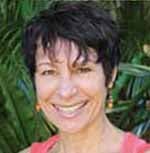By Mary-Louise Parkinson, President IYTA
It was a normal, general hatha yoga class. One held every Monday morning at the exquisitely beautiful Mollymook Beach on the NSW South Coast. The major distraction of the class, other than the golden sandy beach and clear blue sky, being pods of playful dolphins coming to surf the waves and demonstrate their acrobatic prowess.
As a senior lecturer with the International Yoga Teachers Association (IYTA), I have always reminded students of the importance of keeping their eyes open when teaching. I personally follow my students closely: to see if they are understanding what I am saying, to see if they are placing their body into a non-harmful place and to check the look on their faces – puzzled, struggling, strained, in pain or relaxed. I know that sometimes if I am exhausted I would like to close my eyes and speak from that space of inner bliss. However, in my opinion, this is the right of my students, not me.
 Safety and ahimsa (harmlessness) is always my highest concern, for my students and also for me, as a teacher. With Australia now topping the USA as one of the most litigious countries in the world, I like to be confident regarding what I teach, how I teach, and how I care for my students. My classes at Mollymook were usually quite large and attracted a wide variety of people. Regular students included Sydney and Canberra retirees, pregnant girls (my specialty), new mums and several people suffering from cancer.
Safety and ahimsa (harmlessness) is always my highest concern, for my students and also for me, as a teacher. With Australia now topping the USA as one of the most litigious countries in the world, I like to be confident regarding what I teach, how I teach, and how I care for my students. My classes at Mollymook were usually quite large and attracted a wide variety of people. Regular students included Sydney and Canberra retirees, pregnant girls (my specialty), new mums and several people suffering from cancer.
Nancy was one of my regular students. Other than gardening, yoga was Nancy’s weekly, not-to-miss activity. An older student, Nancy had some previous problems with shortness of breath and also hearing. For this reason she always sat at the front of the room, so she could keep an eye on me, but more importantly so I could keep an eye on her. On this day, I noticed Nancy seemed tired and was short of breath. She mentioned she’d had a big weekend gardening but stressed that she would prefer to be at yoga rather than stay at home. I took particular note to watch her throughout the class to remind her to rest. We went through a fairly gentle Dru class, with suggested modifications for those less flexible or with particular conditions requiring assistance. The class progressed as usual. The dolphins entertained everyone, proving what an attraction they are not only for the tourists but also for the locals and, in particular, my yoga students. Then came time for relaxation, the part of the class that everyone waits for. Students were guided to relax in Shavasana and I proceeded to lead them through body awareness and relaxation. I always leave a space of stillness and quiet at this point, but make sure that I myself remain alert and watchful while the students relax.
It was at this moment that I noticed Nancy in some sort of discomfort. She attempted to sit up and grasp at her throat and clothing. When I approached her she said her clothes were constricting her breath and she was hot. I asked her what else was happening and she explained tightness in her chest, weakness and a painful sensation down her left arm side of her body. I could see immediately that this was serious and suspected a heart attack, but didn’t jump to conclusions.
While attending to Nancy, I kept speaking in a calm voice to the class, who were continuing in deep relaxation. I then approached a student who I knew had nursing experience and asked her to help Nancy – and mentioned my suspicions. I left Nancy in capable hands while I went out of the room to get help. Luckily the room I hired was in a Surf Life Saving Club and a couple of off-duty life guards were in the gym, so I asked for their help and at the same time rang an ambulance and Nancy’s daughter.
When I walked back into the room, Nancy was having difficulty breathing but was being attended to, so I calmly spoke to the class (who were still in deep relaxation), guiding them back to the present. I informed them that a member of the class was not feeling well and asked that as they came out of their relaxation, could they calmly and quietly gather their belongings and leave the room. By this stage the ambulance was at the door. The paramedics had administered oxygen to Nancy and were preparing to take her to hospital. Nancy asked if I could go with her. Her daughter had arrived, so she and I accompanied Nancy, all the while keeping a calm disposition and positive attitude. Nancy was taken to the local hospital where they confirmed she had suffered a heart attack and immediately moved her to a larger regional hospital. There they administered a drug – to which she suffered an anaphylactic reaction. She was then flown to Royal Prince Alfred in Sydney to have an emergency operation to fit a stent.
Fortunately Nancy made a full recovery. She returned to yoga once she was well enough and credited the fact that she had attended her regular yoga class instead of staying at home, with saving her life. Here are the lessons I learnt from that experience and would like to share with other yoga teachers:
- Keep your eyes open at all times when teaching – particularly during meditation and relaxation. It is during relaxation that sometimes the body can go into spasm or react emotionally and physically to a past activity or trauma.
- Keep your first aid certificate up to date and know how to recognise the signs for stroke and heart attack.
- Know the background of your students. I knew who in the class had nursing experience. (I also had a student who is a doctor but she was not present on that particular day).
- Ensure that students needing extra care sit at the front of the class so you can keep an eye on them. Ask other students to move if necessary.
- Keep a register of nearest of kin – luckily my contacts were in my phone.
- Don’t panic. All of the students in that class had no idea what was going on until they came out of their guided relaxation. They all calmly and quietly left the room as instructed. This ensured the environment for Nancy was calm and quiet and further aided in her ability to cope with the situation.
- Don’t mess around – act immediately.
The dolphins play on and thankfully Nancy and her family are still watching them. Hopefully you are watching your students.
 Reprinted by kind permission from Mary-Louise Parkinson,
Reprinted by kind permission from Mary-Louise Parkinson,
President of IYTA International Yoga Teachers Association
Previously published in the International Light magazine, Oct-Dec 2015, and Australian Yoga Life.


Recent Comments